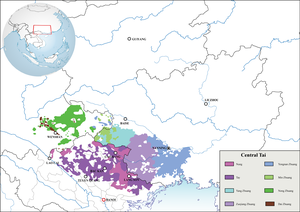Central Tai languages
| Central Tai | |
|---|---|
| (controversial) | |
| Geographic distribution | China, Vietnam |
| Linguistic classification | Kra–Dai |
| Subdivisions |
|
| Glottolog | None deba1238 (Debao–Jingxi–Nung) |
 Geographic distribution of Central Tai languages | |
The Central Tai languages include southern dialects of
Nung and Tày
dialects of northern Vietnam.
Central Tai languages differ from Northern Tai languages in that Central Tai distinguishes unaspirated and aspirated onsets, while Northern Tai generally does not (Li 1977). Southwestern Tai also displays this kind of aspiration contrast.
Classification
paraphyletic
.
Certain languages in predominantly Central Tai-speaking areas, such as
Caolan and Nùng An[1] in northern Vietnam, display Northern Tai features as well. These appear to be mixed languages that are not fully Central Tai or Northern Tai. Jerold A. Edmondson calls Caolan a "tertium quid."[2]
Nung
to be coherent branches under Central Tai.
- Central Tai
- Core Central Tai
- Nung Chau
- Pingxiang Zhuang
- Leiping Zhuang
- Ningming Zhuang
- Tay
- Tay Bao Lac
- Tay Khanh Trung
- Cao Lan
- Nung
- Nung Chao (Longzhou Zhuang)
- Nùng Phạn Slinh
- Nung Inh
- Western Nung/Nung Din (Nong Zhuang)
- Nung Yang (Yang Zhuang)
- Nung An
- Core Central Tai
Languages
Many Central Tai languages are known as Nong 侬 (Nùng in Vietnamese) or Dai 岱 (Tày in Vietnamese).
China
- Longzhou
- Ningming
- Nong Zhuang
- Dai Zhuang
- Min Zhuang
- Yang Zhuang (different from Yang)
- Pyang Zhuang
- Myang Zhuang
Vietnam
- Nung
- Nùng Phạn Slinh
- Nùng Cháo
- Nùng Inh
- Nùng An
- Nùng Giang
- Nùng Dín (=Western Nùng or Nong Zhuang)
- Tày
- Tày Bảo Lạc
- Tày Trùng Khánh
References
Citations
- ^ Nicolson, Beth (2000), "The Nung An Language of Vietnam: Stepchild or Aberrant Son?" (PDF), The Fifth International Symposium on Languages and Linguistics
- ^ Gregerson, Kenneth J., and Jerold A. Edmondson. 1998. Some puzzles in Cao Lan. University of Texas at Arlington.
- ^ Edmondson, Jerold A. Tai subgrouping using phylogenetic estimation. Presented at the 46th International Conference on Sino-Tibetan Languages and Linguistics (ICSTLL 46), Dartmouth College, Hanover, New Hampshire, United States, August 7–10, 2013 (Session: Tai-Kadai Workshop).
Sources
- Li, Fang-kuei. 1977. Handbook of Comparative Tai. Honolulu, Hawaii: University of Hawaiʼi Press.
- Pittayaporn, Pittayawat. 2009. The Phonology of Proto-Tai. Ph.D. dissertation. Department of Linguistics, Cornell University.
